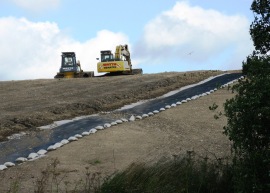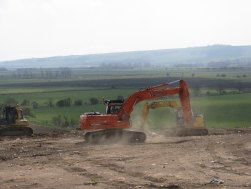Some mornings on the way over the Yorkshire Wolds to Scarborough I like to take in the back roads. One such route crosses East Heslerton Wold to arrive at the top of Sherburn Brow, where it encounters the Wolds Way long distance trail, which follows the road downhill towards Sherburn before regaining the crest of the brow. Now this un-sung viewpoint offers a cracking view across the Vale of Pickering any day of the year*, but the added bonus on this occasion was a mixed flock of finches alighting in a skeletal hedgerow. The birds were enjoying the bounty of a stewardship crop planted as a winter food source for farmland birds. These wild bird mixtures can be a vital crutch to the survival of some of our smaller seed-eating birds in the winter countryside and I stopped briefly to appreciate the crop and the flighty flock of winged seed-seekers.
A wild bird seed crop (sometimes called WBS mix by those in the know) is a tailored mix of arable crop plants left unharvested over one or two winters. Typically they include a mix of starchy cereals and oil-rich brassicas. Wheat, barley or triticale, a forbear of modern wheat, could provide the cereal element for instance. Providing seeds with high lipid content could be oil-seed rape, fodder radish or kale. Such brassicas left to seed will provide seed pods for a couple of seasons and the sought after seeds will be held tightly by the plant until a prying beak makes good its entry. Other seed bearing crops like millet are sometimes are included in the mix to increase the variety. The whole lot grows together and additionally provides cover and shelter for game birds in the barren months of winter and spring.
One of the advantages of a sacrificial crop like this is that the seeds remain attached to upright stalks, safe from the rot and mould they would quickly succumb to if scattered on the ground. It can produce quite a wildlife spectacle if carefully located, by a thick hedge or a woodland for safety and warmth. This particular location, on my visit, had attracted 40 or more Bramblings, among dozens of Goldfinches and Chaffinches, with a few Greenfinch, Linnet and Bullfinch for good measure. While we enjoy our garden bird visitors attracted to seed feeders and bird tables it is worth thinking about the feast we might have in the countryside if a few more hectares of wild bird seed mix were sown on every farm. To recover their dwindling populations our farmland birds need not only to survive through the winters but emerge fit enough to breed the following spring. It made my week to see Bramblings and Linnets in double figures. Will future generations enjoy such treats I wonder?








